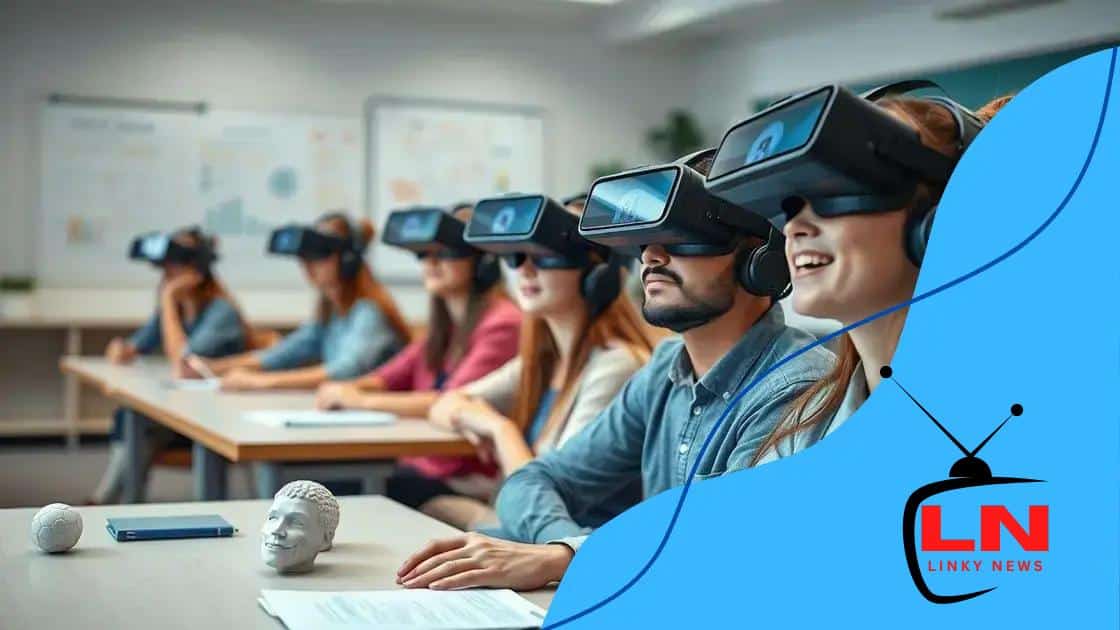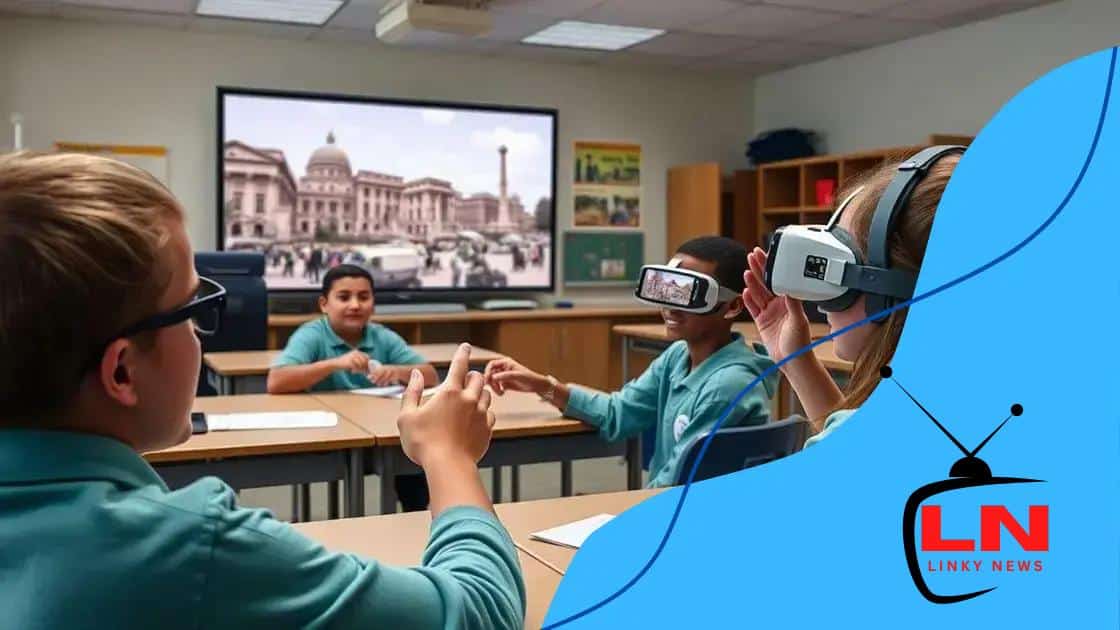How AR is being used for hands-on learning experiences

Augmented reality (AR) is transforming hands-on learning experiences by enhancing engagement, providing interactive content, and allowing students to visualize complex concepts in various subjects.
How AR is being used for hands-on learning experiences is reshaping education by offering interactive ways to engage students. Imagine students exploring anatomy through 3D models or historical events through immersive simulations. Sounds exciting, right?
Understanding augmented reality in education
Understanding augmented reality (AR) in education is crucial for realizing its potential benefits. AR blends digital content with the real world, allowing students to interact with learning material in new ways. Imagine a history lesson where students can walk alongside a virtual dinosaur or explore ancient ruins right in their classroom. This hands-on experience fuels curiosity and engagement.
What is augmented reality?
Augmented reality enhances the real world using technology. By layering digital information over our surroundings, AR provides a unique way to learn. For instance, students can use their smartphones to view 3D models or gain insights into complex subjects like science and geography.
Benefits of augmented reality in education
Using AR in the classroom has numerous advantages:
- Increased engagement through interactive learning.
- Enhanced understanding of difficult concepts.
- Personalized learning experiences for diverse students.
Students are naturally curious. When they see information visually represented, it becomes easier to grasp complex ideas. For example, using AR to visualize the solar system allows students to explore space in their classroom. This helps them to connect with the material on a deeper level. Schools can engage their students through exciting educational tools that appeal to various learning styles.
Moreover, implementing AR in education opens doors to innovative teaching methods. Instructors can create immersive lessons that inspire creativity. This technology encourages students not just to memorize facts but to explore and ask questions. Imagine a biology class where students can dissect a virtual frog, gaining hands-on experience without the mess!
AR also supports collaboration among students. When working on AR projects, classmates can team up to explore and learn from each other. This teamwork is invaluable in developing communication skills and fostering friendships. As technology continues to evolve, we can expect even more exciting possibilities in education.
Ultimately, understanding how augmented reality functions in educational settings helps us appreciate its potential. By blending creative digital content with traditional teaching methods, AR has the power to revolutionize learning experiences for students around the world, capturing their interest and enhancing their understanding.
Benefits of AR for hands-on learning
The benefits of AR for hands-on learning are vast and transformative. By integrating augmented reality into educational environments, teachers can enhance student engagement and understanding. Imagine students exploring complex subjects through interactive experiences that make learning fun and effective.
Enhancing Engagement
One major advantage of AR is its ability to capture students’ attention. Traditional teaching methods can sometimes fall flat, but AR brings lessons to life, encouraging active participation. When students interact with virtual objects, they become more involved in their learning process. This excitement promotes curiosity and a deeper connection to the material.
Improving Understanding of Concepts
AR also helps students grasp challenging concepts more easily. Instead of reading about a topic, they can visualize it via 3D models that illustrate how things work. For example, students can learn anatomy by examining a virtual human body, allowing them to see how organs function in real-time. This method of experiential learning helps solidify their knowledge.
Promoting Personalized Learning
Another key benefit of AR in education is its ability to support personalized learning. Students learn at different paces, and AR can cater to individual needs. Some might benefit from visual aids, while others may prefer hands-on interactions. AR can adapt to various learning styles, providing tailored resources that keep all students engaged and motivated.
- Offers immediate feedback through interactive elements.
- Encourages collaborative learning by fostering teamwork.
- Helps students develop critical thinking skills.
In addition to these advantages, AR can create safe learning environments. For instance, students can engage in simulations of real-world scenarios without risks. They can practice skills, make mistakes, and learn from them without real-life consequences. This safe space for exploration fosters confidence as students become more comfortable with new ideas and skills.
Overall, the benefits of AR for hands-on learning create a more dynamic educational experience. By leveraging this powerful technology, educators can inspire students, stimulate creativity, and encourage a lifelong love of learning.
Real-world examples of AR in classrooms

Exploring real-world examples of AR in classrooms showcases how this technology can enhance education. Schools around the globe are successfully integrating augmented reality into their curricula, leading to more interactive and engaging learning environments. For instance, students can experience subjects beyond textbooks, making lessons vivid and memorable.
Virtual Field Trips
One popular use of AR is virtual field trips. Students can explore ancient cities, underwater worlds, or outer space without leaving the classroom. Using AR headsets or tablets, they can immerse themselves in these environments, gaining knowledge that textbooks alone cannot provide.
Interactive Science Lessons
Another fantastic example is in science classes. With AR, students can visualize complex biological processes, like photosynthesis or cellular division, in real-time. They can manipulate virtual cells or witness chemical reactions unfold before their eyes. This hands-on approach fosters a deeper understanding of scientific concepts.
Historical Reenactments
AR also allows students to participate in historical reenactments. Imagine learning about the American Revolution by seeing battle scenes play out in the classroom. Students can interact with historical figures, learning contextually while experiencing events as if they were there. This immersive approach makes the subject matter come alive.
- Augmented reality apps like Google Expeditions offer guided tours of various educational sites.
- AR-enhanced textbooks provide interactive elements, such as 3D models and animations.
- Schools are using AR to teach languages through interactive tools, making vocabulary learning more fun.
Furthermore, math classes have also seen the benefits of augmented reality. Students can visualize geometric shapes and graphs in three dimensions, allowing for better spatial understanding. AR applications can guide students through complex problems step-by-step, making learning math less intimidating.
In arts education, students can use AR to see famous artworks in their own environments. They can learn about different styles and techniques while creating their own art. This dual exposure inspires creativity and appreciation for the arts.
These real-world examples illustrate how AR can transform classrooms into dynamic learning spaces. As technology continues to evolve, the possibilities for using augmented reality in education will expand, further engaging students and enriching their learning experiences.
Implementing AR tools in educational settings
Implementing AR tools in educational settings can transform the way students learn. Many schools are exploring augmented reality to engage learners and make lessons more exciting. With the right tools, teachers can create immersive experiences that encourage exploration and curiosity.
Choosing the Right AR Tools
When selecting AR tools, it is essential to consider the needs of students and the curriculum. Various applications cater to different subjects, from science to history. Teachers can find platforms that provide interactive 3D models, virtual field trips, and simulations. For instance, apps like Google Expeditions allow students to visit locations worldwide without leaving the classroom.
Training Educators
It’s vital to train educators in using these new technologies. Professional development programs can help teachers become comfortable using AR tools and integrate them into their lessons. Educators can join workshops or online courses to understand best practices for incorporating augmented reality into their teaching.
Collaboration is also essential. School districts can encourage teachers to share ideas and resources. Forming a community of practice can help educators learn from each other’s experiences. This teamwork fosters innovation and creates a supportive environment for adopting new technologies.
- Involve students in the design process to tailor AR tools to their interests.
- Start with small projects to gradually incorporate AR into the classroom.
- Evaluate the effectiveness of AR tools regularly to ensure they meet educational goals.
To successfully implement AR tools, schools should ensure access to the necessary technology. This might include tablets or smartphones capable of running AR applications. Schools can also consider partnerships with technology companies to provide devices or funds for resources.
Lastly, continuous feedback from students can offer insights into their experiences with AR tools. Surveys or informal discussions can help educators understand how students are engaging with the material and what improvements can be made. Students often have valuable perspectives that can guide future implementations.
By thoughtfully incorporating AR tools into educational settings, schools can create dynamic learning environments that enhance engagement and understanding.
Future trends of AR in learning environments
The future trends of AR in learning environments hold exciting possibilities for education. As technology advances, augmented reality will play an even more significant role in how students learn and interact with content. This will lead to innovative teaching methods that inspire creativity and curiosity among learners.
Integration with Artificial Intelligence
One major trend is the integration of AR with artificial intelligence (AI). This combination can create adaptive learning experiences that cater to individual student needs. AI can analyze how a student interacts with AR content and adjust difficulty levels accordingly, providing tailored paths for learning.
Expansion of AR Content
As AR technology becomes more accessible, the variety of AR content available for educational purposes will grow. More developers will create immersive applications that cover different subjects, from math and science to literature and art. This diversity will provide teachers with rich resources to engage their students in multiple ways.
- Teachers can use AR to create personalized learning experiences.
- Access to AR tools will improve, making it easier for schools to adopt.
- Collaboration between educational institutions and tech companies will increase.
Moreover, the use of AR in remote learning environments will likely expand. With ongoing advancements in virtual classrooms, students can engage with interactive elements from home. This can bridge gaps in education for students in remote areas, allowing them to experience immersive learning opportunities from anywhere.
Additionally, as mobile technology develops, students will have more access to AR tools directly on their devices. This ease of access will encourage more learners to use AR in their studies. Imagine students discovering complex concepts through interactive experiences on their smartphones or tablets!
Furthermore, interdisciplinary teaching will benefit from AR. Educators can blend subjects, such as combining science with art, to create engaging projects. AR can help visualize the connections between various fields, encouraging critical thinking and creativity.
Finally, the future of AR in education will place emphasis on fostering collaboration. Students will work together on AR projects, encouraging teamwork and communication skills. This collaborative approach will prepare students for real-world challenges, emphasizing the importance of working well with others.
In conclusion, the integration of augmented reality in education is changing how students learn and interact with information. By using AR tools, educators can create more engaging and interactive learning environments. The future holds exciting opportunities for AR to enhance collaboration, foster creativity, and provide personalized learning experiences. As technology advances, students will benefit from richer educational experiences that prepare them for the world ahead.
FAQ – Frequently Asked Questions about Augmented Reality in Education
What are the benefits of using AR in classrooms?
AR enhances student engagement, provides interactive learning experiences, and helps in understanding complex concepts in a visual way.
How can teachers implement AR tools in their lessons?
Teachers can choose suitable AR applications, receive training, and integrate them into their existing curriculum to create immersive lessons.
Is AR technology expensive for schools?
While initial setup costs can be high, many AR tools are becoming more affordable, and some free applications are available for educators.
What future trends can we expect for AR in education?
Future trends include integration with AI, expanding AR content, and increased collaboration through enhanced mobile technology.





